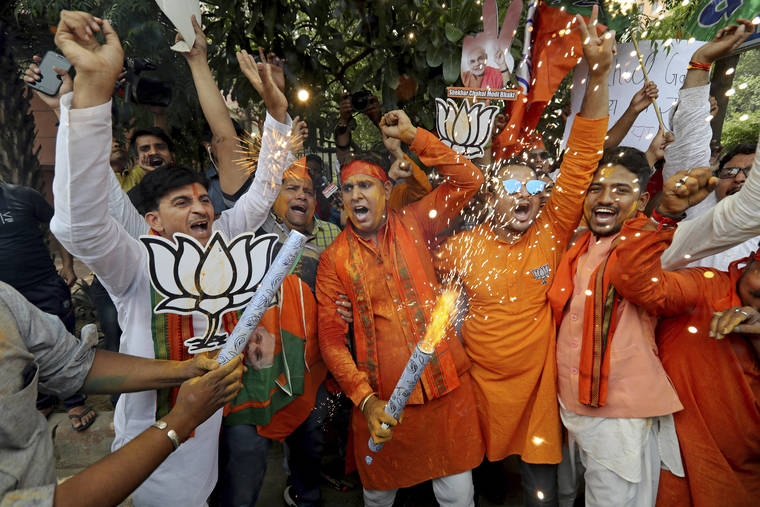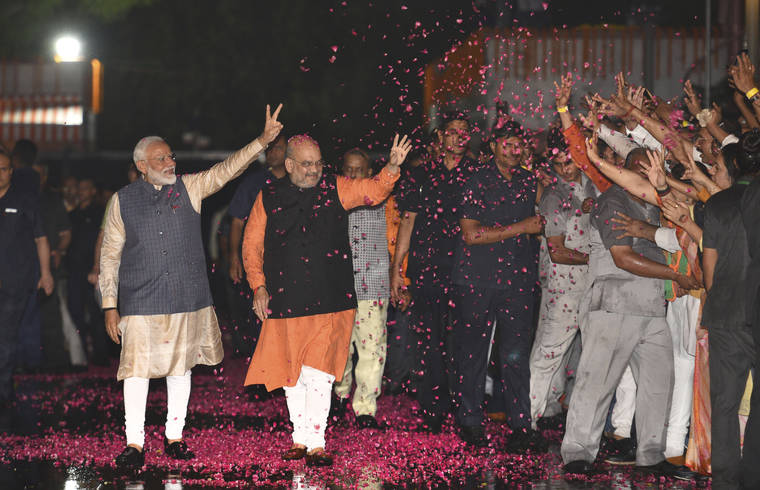Modi surges to victory in India on Hindu-first platform

Bharatiya Janata Party (BJP) workers celebrate outside BJP headquarters in New Delhi India, Thursday, May 23, 2019. Indian Prime Minister Narendra Modi and his party have a commanding lead in early vote counting from the country’s six-week general election. (AP Photo/Altaf Qadri)

Indian Prime Minister Narendra Modi and Bharatiya Janata Party (BJP) President Amit Shah greet supporters on arrival at the party headquarters in New Delhi, India, Thursday, May 23, 2019. Modi’s Hindu nationalist party claimed it won reelection with a commanding lead in Thursday’s vote count, while the head of the main opposition party conceded a personal defeat that signaled the end of an era for modern India’s main political dynasty. (AP Photo)
NEW DELHI Narendra Modi, Indias charismatic but polarizing prime minister, was headed Thursday for a landslide election victory, propelling his Hindu nationalist party to back-to-back majorities in parliament for the first time in decades.
NEW DELHI — Narendra Modi, India’s charismatic but polarizing prime minister, was headed Thursday for a landslide election victory, propelling his Hindu nationalist party to back-to-back majorities in parliament for the first time in decades.
With most of the votes counted, Modi’s stunning re-election mirrored a global trend of right-wing populists sweeping to victory, from the United States to Brazil to Italy, often on a platform promoting a tough stand on national security, protectionist trade policies and putting up barriers to immigration.
The victory in India was widely seen as a referendum on Modi’s Hindu-first politics that some observers say have bred intolerance toward Muslims and other religious minorities, as well as his muscular stance on neighboring Pakistan, with whom India nearly went to war earlier this year.
“India wins yet again,” Modi exulted in a tweet.
Election Commission data showed Modi’s Bharatia Janata winning 158 seats and in the lead for 145 more, which would catapult the party well beyond the simple majority in the 545-member lower house of Parliament required to govern. The results spelled another nail in the coffin of the main opposition Indian National Congress party, which picked up 31 seats and was leading in 21 other contests. Its president, and the scion of modern India’s most powerful political dynasty, personally conceded his seat to BJP, signaling the end of an era. The final tally was not expected until Friday.
Addressing thousands of party workers celebrating the outcome, Modi urged the world to “recognize India’s democratic power.” He attributed the party’s showing to his policies aimed at improving the lot of the nation’s poor, including free medical insurance, relief for distressed farmers and a highly popular program to build 100 million toilets in a nation where basic sanitation remains a major problem.
The election victory was a resounding endorsement of the 68-year-old Modi, whose economic reforms have had mixed results but whose background as a social underdog from a lower-caste Hindu family clearly inspired some in India’s highly stratified society, appealing to tens of millions of Indians seeking upward mobility. Critics have said his Hindu-first platform risks exacerbating social tensions in the country of 1.3 billion people.
Since Modi led the Bharatiya Janata Party to power in 2014, Hindu mobs have lynched dozens of Muslims and lower-caste Dalits — people in India’s strict social hierarchy once considered “untouchable” — for consuming or slaughtering cows, which Hindus consider sacred.
Modi has largely shown complacency toward rising incidents of violence and discrimination against minorities, and to rhetoric like that of his party’s president, who called mainly Muslim Bangladeshi migrants to India “termites,” or one of BJP’s candidates for parliament, who described peace activist Mahatma Gandhi’s assassin as a “patriot.” Activists, lawyers, journalists and academics have been harassed and even prosecuted under anti-terrorism and anti-sedition laws that Human Rights Watch calls draconian.
But on the campaign trail, Modi seized on his personal narrative, presenting himself as a self-made man with the confidence to cut red tape and unleash India’s economic potential, and labeling Congress party president Rahul Gandhi as an out-of-touch member of the elite. This resonated in India, where an anti-corruption movement helped lead to the ouster of Congress partly for the perceived excesses of the Gandhi family, and for the bloated and inefficient bureaucracies Congress ran as the ruling party for nearly a half-century after independence.
Gandhi conceded defeat for his own parliamentary seat to his BJP rival in Amethi, a constituency in the northern state of Uttar Pradesh that had for decades been a Congress party bastion. But Indian election rules allow candidates to run in more than one constituency, and Gandhi was ahead in the race for another seat he contested in the southern state of Kerala.
Even before the election commission had released any official results, calls came in from around the world — U.S. President Donald Trump, Chinese President Xi Zinping, Israeli Prime Minister Benjamin Netanyahu— rushing to congratulate Modi.
An estimated 600 million voters cast ballots in India’s six-week polls, a testimony to the vibrancy of the world’s largest democracy just 72 years since India won independence from British colonial rule.
Voters expressed confidence that Modi could jumpstart India’s stalling economy, despite his poor first-term record and failure to deliver on his pledge to create jobs.
The BJP harnessed social media, including Twitter, where Modi has 47.4 million followers, and WhatsApp to reach out to millions of supporters.
Modi also capitalized on a suicide bombing in Kashmir in February that killed 40 Indian soldiers. India retaliated with airstrikes at alleged terrorist training camps in Pakistan, fanning the flames of nationalism and helping the BJP turn voters’ attention away from the flailing economy and onto matters of national security.
As votes were being counted across India, Pakistan’s military said it successfully test-fired a long-range ballistic missile capable of carrying a nuclear warhead.
Tensions with Pakistan “gave him the narrative he needed to counter all these allegations of non-performance, unemployment and rural distress. It reenergized him and enabled him to reclaim his image as a strong leader India needs at this juncture,” political commentator Arti Jerath said.
The BJP’s performance “is absolutely stunning. Modi is the predominant leader in India today. He has pushed everybody else aside. Nobody in the opposition is a match for him,” Jerath added.
Trends in the election data suggest that BJP’s strategy of pursuing an aggressive campaign in eastern India paid off, with the party breaking into the citadels of Trinamool Congress Party in West Bengal state and the Biju Janata Dal in Odisha state.
The biggest losers appear to be the Communists who ruled West Bengal state for 34 years until they were ousted by Mamata Banerjee’s Trinamool Congress Party in 2011. Coalition partners of the Congress-led government in New Delhi between 2004 and 2008, the Communist Party of India (Marxist) was leading in only three constituencies and the Communist Party of India in two constituencies.
Outside BJP headquarters in New Delhi, hundreds of people cheered and shouted party slogans, lifting cardboard cutouts of Modi and BJP President Amit Shah into the air as other people played drums and set off fireworks.
Mohit Sharma, a 29-year-old who runs a bathroom fittings business, said India had never had a prime minister like Modi.
“In the past, when leaders after they won elections, they sat in air-conditioned rooms and they never reached out to people, but Modi was never like that. He was always connected to the people through social media,” Sharma said.
———
Associated Press writers Rishabh R. Jain, Bharatha Mallawarachi and Ashok Sharma contributed to this report.

